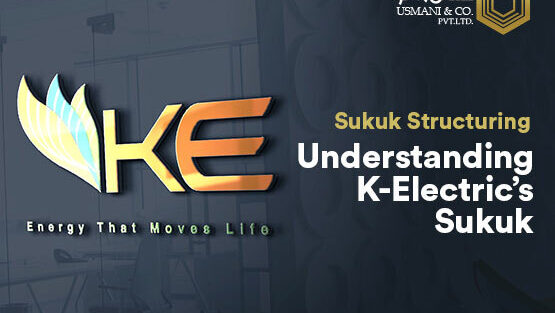The successful issuance of K-Electric Sukuk back in 2015 led to another effective Sukuk issuance by K-electric in 2020. The Diminishing Musharakah Sukuk in 2015 was jointly arranged by Meezan Bank Limited and Habib Bank Limited and was awarded a rating of AA+ by JCR-VIS and A+ by Islamic International Rating Agency (Bahrain). It was the largest listed corporate Sukuk in Pakistan, the shariah structuring of which was approved by Dr. Imran Usmani and other prominent scholars who were part of the shariah advisory board. (Source: https://www.ke.com.pk/investor-relation/ke-sukuk/)
Another milestone that we all are a witness to is the recent effective issuance of Sukuk or Islamic bonds by K- Electric, the subscription of which closed on 3rd August 2020; two weeks in advance. Its early closure is not just another testament to the investor’s trust in Islamic bonds but also the increased use of Islamic financial instruments in Pakistan’s Capital Market. Sukuk, all over the world, has become increasingly popular as a feasible and viable shariah-compliant long-term financing instrument.
Moody’s investor’s service sector report 2019 showed an increase of 36% international Sukuk issuance, which was the highest recorded in the previous four years. However, the first half of the year 2020 showed a decline of 5% of Sukuk issuance compares to 2019 to $170 billion. The reason for the decline being the obvious; coronavirus. It is hoped that in the second half of 2020 the issuances will increase worldwide.
K-Electric Sukuk issuance taking on the lead with the second half of 2020 with an oversubscription of 2.5 times; it is hoped that the issuance of this Sukuk by the private sector for the infrastructural purpose will bring Karachi’s power supply into a surplus position. It is also paramount to understand that the oversubscription of PKR 25 billion K-Electric Sukuk that had to be closed two weeks in advance was more acceptable to the public as it did not interfere with the moral conflict of taking on an interest bearing conventional bond.
The origin of Sukuk can be traced back to the first century of the Islamic Calendar during the Ummayad Caliphate. In the Arabic language, the word Sukuk is a plural of the word ‘sakk’, which means a legal instrument, deed, or cheque. Imam Malik is his famous treatise, Al-Muwatta has described the use of sakk by the Ummayad Government. The ‘sack’ was also known as ‘grain permit’ and it entitled the holders to a certain amount of commodities from the state government treasury upon maturity. Since it was backed by state obligation, it was traded among Sukuk holders and was marked as a tradable instrument by Muslims’ in the past (Islamic Capital Markets, Obiyathullah Bacha).
In Islamic Finance, a more accurate translation would be Islamic investment certificate or participation certificates. The holder of this certificate is the beneficial owner (in proportion) of the underlying assets of the Sukuk or ownership in a business venture along with the profit or loss associated with the Sukuk or business venture (Sukuk Principles and Practices, ISRA). Bahrain-based Accounting and Auditing Organization for Islamic Financial Institutions (AAOIFI) defines Sukuk as “certificates of equal value representing undivided shares in ownership of tangible assets, usufruct, and services or (in the ownership of) the assets of particular projects or special investment activity”.
In modern times, Sukuk has been used as a financial instrument to raise large amounts of cash or capital from investors and it can be done by developing various structures of Sukuk with underlying assets.
The various structures of Sukuk could be sale based (Murabahah), lease based (Ijarah), and equity-based (mudarabah, musharakah, and wakala) . However, even a combination of all these is possible.
Lets’ first delve into a basic musharakah Sukuk structure in order to further proceed into Karachi Electrics’ diminishing musharakah Sukuk.
Basic Musharakah Sukuk Structure

The company (originator) and investors enter a musharakah contract and become joint owners of a pool of assets through a Sukuk issuance process. As such, Musharakah Sukuk is securities where holders are owners of a specific asset. They will either benefit or lose from an increase or a decrease in the price of the underlying asset. It is additionally characterized by predefined maturity date and is typically tradable in the secondary market.
The Accounting and Auditing Organization for Islamic Financial Institutions in its Shariah Standard No. 17 (3/6) defines Musharakah Sukuk as ‘certificates of equal value issued with the aim of using the mobilized funds for establishing a new project, developing an existing project or financing a business activity on the basis of any partnership contract so that the certificate holders become the owner of the project or assets of the activity as per their respective shares, with the Musharakah certificates being managed on the basis of participation or mudharabah or an investment agency’.
The concept of diminishing musharakah structure has been established in the recent past. It is a contract in which a financier and a client enter joint ownership of a property, equipment, or a joint commercial enterprise. The share of the financier is further divided into a number of units and each unit is periodically bought by the client until the client becomes the sole owner of the property, equipment, or joint ownership. (Islamic Finance, Dr. Muhammad Imran Usmani)
According to the Accounting and Auditing Organization for Islamic Financial Institutions in its Shariah Standard No. 12 (5/1) ‘Diminishing Musharakah is a form of partnership in which one of the partners promises to buy the equity share of the other partner gradually until the title to the equity is completely transferred to him.’ The diagram below is an illustration of Karachi Electric diminishing musharakah Sukuk for further elaboration of this concept.

Source: https://www.sukuk.com/sukuk-new-profile/k-electric-limited-4372/#/?playlistId=0&videoId=0
In this structure, 75% of the pool of assets is sold to investors or Sukuk holders through Pre-IPO and IPO, whereas 25% is still owned by KE. Thereby in this musharakah arrangement, KE and Sukuk holders enter joint ownership of 25:75 respectively. The 75% that is owned by Sukuk holders is then given on lease to KE for which KE provides rent to Sukuk holders for the usufruct of these assets. This arrangement is further followed up by the gradual purchasing of these assets by KE during the seven-year tenure of the Sukuk.
There are some Sukuk that are structured in the sale and leaseback model in which a particular usable property is purchased from the Sukuk issuer and then it is leased back to the seller with the intention that once the lease is matured the asset would be sold back to the original seller(originator). Firstly, the originator will establish a special purpose vehicle (SPV). The SPV is legally separate from the originator and Sukuk holders. The Originator then pledges or transfers the asset which will become the underlying asset of the Sukuk to this newly established SPV. These underlying properties represented by Sukuk will be held at trust by the special purpose vehicle (SPV) or trust and the lease rentals that are received from the originator for the use of the asset(usufruct) are distributed among the Sukuk holders on a pro-rata basis of the investment.
However, one may wish to understand that what makes such structuring of a Sukuk different from conventional bonds even though to an onlooker the result, being the periodic rentals, might appear like conventional bonds.
So what exactly differentiates Sukuk from conventional bonds?
- The Sukuk process involves issuers and investors via Islamic contracts, whereas a conventional bond involves lenders and borrowers.
- Conventional bond is a debt-based instrument whereas Sukuk are not debt-based but rely on ownership of specific assets and its cash flows.
- Sukuk issuance always has an underlying asset and Sukuk holders have a right to the ownership of the underlying asset and its cash flows; a bond does not have an underlying asset unless it is collateralized.
- In Sukuk issuance, where the funds are raised to be used to finance needed tangible assets, the specificity of assets is important, in the issuance of bonds it can be used by the issuer for any general financial need which does not need to specify.
- Income received by Sukuk holders (investors) must be derived from the cash flows generated by the underlying asset, not from other sources external to the asset.
- Sukuk issuers will securitize assets to issue Sukuk. Investors who plan to purchase or buy the Sukuk will get a certificate that represents ownership of the asset, risk, and cash flows. Upon maturity, those investors are qualified to get the money equivalent to the value of the Sukuk. The value of Sukuk could be varied according to the value of the asset that is backing them. These criteria also differentiate Sukuk from bonds.
- If these Sukuk are traded in the secondary market, they must have tangible assets more than 50% as per the guidelines given by shariah scholars, which is not the case with bonds as it does not represent any underlying asset.
It is hoped that with more of such Sukuk issuance, more infrastructural projects can be undertaken at the government and corporate levels which will not only benefit the economy at large but also remove economies from overreliance on debt.
To further understand the concept of Sukuk, do read the securitization chapter in Islamic Finance, Dr. Muhammad Imran Ashraf Usmani (https://www.usmaniandco.com/resources/)
Written by: Sadaf Sawant
Executive Projects’ Coordinator and Panel Member at Usmani & Co.


